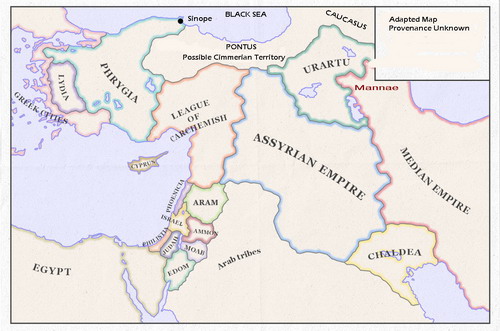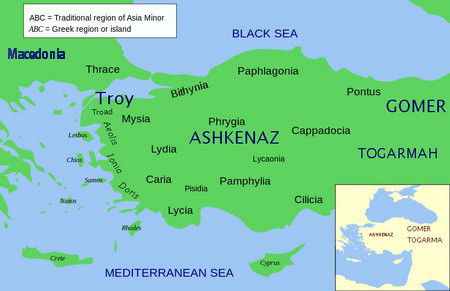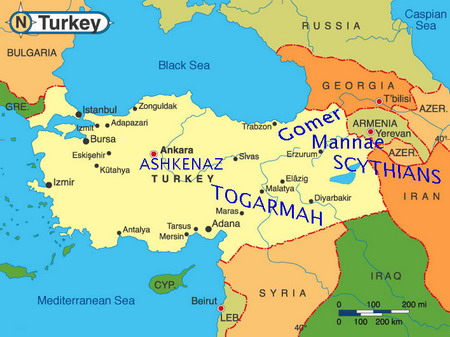Descendants of Gomer (2 February, 2015, 13 Shevet, 5775)
Continued from Gomer the Gentile and from Ashkenaz, and from Togarmah

Contents:
1. Riphah and the Sons of Gomer
2. Paphlagonia
3. Josephus and the Scythians
4. Gomer, Riphath and the Celts
5. The Riphaean Mountains of Riphat
6. The Franks and Gomer
7. Gomer in Eastern Europe and Germany?
==============================
===============================
1. Riphah and the Sons of Gomer
The sons of Gomer were Riphath along with Ashkenaz and Togarmah.
This is important to us since we have seen evidence of a union or association that was to take place between Gomer and the Ten Tribes of Israel. Historically where Gomer and his sons were to be found, the Ten Tribes were to be there as well or at least nearby and in the same cultural sphere.
In this series we have dealt with the identification of Gomer, of Ashkenaz, and of Togarmah. We are now dealing with Riphat.
==============================
===============================
2. Paphlagonia
Riphah was said by Flavius Josephus to have been the ancestor of the "Riphatheans, now called Paphlagonians". Paphlagonia is in northeast Turkey by the Black Sea.
We saw earlier how Paphlagonia was an area of the Cimmerians i.e. of Gomer. The two opinions do not contradict each other since Riphat was an offshoot of Gomer.
This area was also one of Assyrian settlement which may have also meant the relocation of Exiles taken from other parts of the Assyrian Empire.
Diodorus Siculus (Book II, s. 43):
"many conquered peoples were removed to other homes, and two of these became very great colonies; the one was composed of Assyrians and was removed to the land between Paphlagonia and Pontus, and the other was drawn from Media and planted along the Tanais (Don River, Scythian territory within the Ukraine)."
See: Assyro-Germans by Ricardo Lopez
http://hebrewnations.com/articles/peoples/germany/assyria.html
==============================
===============================
3. Josephus and the Scythians
# And so many were the countries that had the children of Japhet for their inhabitants. Of the three sons of Gomer, Aschanax founded the Aschanaxians, who are now called by the Greeks Rheginians. So did Riphath found the Ripheans, now called Paphlagonians; and Thrugramma the Thrugrammeans, who, as the Greeks resolved, were named Phrygians #
(Josephus, Antiquities of the Jews, Bk. 1, ch vi. 1)
Note: Josephus above identifies Togarmah with Phrygia.
I understand the Rheginians (identified as Ashkenaz by Josephus) to be the people of Rhages which was a Scythian center in Media and later in the Persian Empire. It was also an area where descendants of the Ten Tribes congregated as recalled in the Apocryphal Book of Tobias.
Josephus however identified the Scythians in general with Magog.
# Magog founded those that from him were named Magogites, but who are by the Greeks called Scythians. #
We should realize that identifications sometimes refer to people who were found in or ruled over certain areas without necessarily comprising the bulk of the population. Also, it was an Age of Great Etrhnic Migraion with nations moving backwards and forwards. It follows that one people could legitimately be identified with several places and several places could be given as the place of one people.
The source By Dr. Lewis Moncrief below says:
#Josephus called the sons of Ashkenaz "the Rheginians," and a map of the ancient Roman Empire places them in the area of modern Poland, Czechoslovakia and Germany to the banks of the Danube River. So also does the Jewish Talmud." #
It may well be that Jewish sources place Ashkenaz in Eastern Europe as well as Germany but I am not familiar with it, neither do I know where the Talmud confirms this BUT, as stated, there may be Rabbinical sources along these lines. It is worth noting that Eastern Europe was known as European Sarmatia and the son of Eliyahu of Vilna said the Ten Tribes at one stage had gone to this area.
# Hippolytus of Rome made Riphat the ancestor of the "Sauromatians", as distinct from the "Sarmatians", whom he called descendants of Riphath's elder brother, Ashkenaz.#
Note: Both the Sauromations and the Sarmatians were in Scythia though, in part, distinct from the Scythians.
==============================
===============================
4. Gomer, Riphath and the Celts
Josephus said:
# For Gomer founded those whom the Greeks now called Galatians, [Galls,] but were then called Gomerites. #
Galatians (people)
http://en.wikipedia.org/wiki/Galatians_(people)
From Wikipedia, the free encyclopedia
The Galatians were a Celtic people that dwelt mainly in the north central regions of Asia Minor or Anatolia, in what was known as Galatia [part of Phrygia], in today's Turkey. In their origin they were a part of the great Celtic migration which invaded Macedon, led by Brennus. The original Celts who settled in Galatia came through Thrace under the leadership of Leotarios and Leonnorios c. 278 BC. These Celts consisted mainly of three tribes, the Tectosages, the Trocmii, and the Tolistobogii, but they were also other minor tribes. They spoke a Celtic language, the Galatian language, which is sparsely attested.
http://en.wikipedia.org/wiki/Galatian_language
Galatian was contemporary with and closely related to the Gaulish language.
In the 4th century St. Jerome (Hieronymus) wrote in a comment to Paul the Apostle's Epistle to the Galatians that "apart from the Greek language, which is spoken throughout the entire East, the Galatians have their own language, almost the same as the Treveri". The capital of the Treveri was Trier, where Jerome had settled briefly after studying in Rome).[11][12]
Trier is historically called Treves in English. It is a city in Germany on the banks of the Moselle just across the border from Luxembourg to the northeast of France.
The Galatians appear to have migrated from Gaul. The Tectosages were a Gallic tribe in southern France.
By implication it could be understood that Josephus identified the Gauls with Gomer.
# August Wilhelm Knobel proposed that Riphath begat the Celtic peoples, who according to Plutarch had crossed from the Riphaean Mountains while en route to Northern Europe.
Some versions of the Middle Irish work Lebor Gabhala Urenn give as an alternate name "Riphath Scot" son of Gomer, in place of Fenius Farsa, as a Scythian ancestor of the Goidels.#
See Also:
Celtic - Serbian parallels
http://www.eupedia.com/forum/threads/26549-Celtic-Serbian-parallels
# Celtic or celticized tribes of Scordisci/Serdi that lived along Danube in what is now Serbia might have been former tribal identity of Serbs... also I relate both proto-Serbs and proto-Celts to peoples known as Cimmerians and Serians... Welsh people are often considered to be Cimmerians in origin... #
==============================
===============================
5. The Riphaean Mountains of Riphat
The Riphaean Mountains were associated with Riphat.
The entry below is therefore of interest.
Smith's Bible Dictionary
http://www.christnotes.org/dictionary.php?dict=sbd&id=3660
'Riphath' means spoken
Riphath: the second son of Gomer. (Genesis 10:3) The name may be identified with the Rhipaean mountains, i.e. the Carpathian range in the northeast of Dacia.
The Riphean Mountains are mountains mentioned by authors of classical antiquity (Apollonius of Rhodes, Aristotle, Hecataeus of Miletus, Hippocrates, Ptolemy, Plutarch, and others), but whose location is uncertain.
Later Roman writers applied the term to mountains in the north of Europe or Asia. Pomponius Mela placed them within the Arctic Circle. Pliny the Elder assigned them to the Ural Mountains. Noah Webster wrote that the earliest geographers applied the term to the Alps in Switzerland and claimed that they are the source of the Danube. All sources agree that the Riphean mountains were cold and blanketed in snow.[1]
The people living around the mountains in antiquity were variously called Riphaeans (Mela), Arimphaei (Pliny), or Arimaspi. The name of the mountains has also been connected by Christian theologians with Riphath, son of Gomer in Genesis 10. The Book of Jubilees (8:12, 16, 28) mentions a mountain range it calls Rafa, which Professor R.H. Charles associated with the Riphaean, i.e. Ural Mountains.
===============================
===============================
6. The Franks and Gomer
The Medieval Jewish work "Josephon" (falsely attributed to Josephus) related the Franks to Gomer.
Troy was in the west of Anatolia but here too at a later date Cimmerians were to be found.
Sons of Japheth Part II: Gomer
http://www.ccg.org/weblibs/study-papers/p046b.html
Extracts:
The Kings of the Francs trace their ancestry back through Charlemagne and the kings of the Francs to their ancestors who were the Cimmerians or the Gimmery. The line goes back to Antenor I king of the Cimmerians ca 500 BCE. From there imputed lineage to the sons of Priam of Troy is claimed.
The town we now know as London was originally built as New Troy or Trinovantium and the occupants were the tribe of the Trinovantes.
Whilst Colchester was the major city in England at the time London was still of some significance. Lud is listed as the elder brother of Caswallon who is listed as Cassivelaunos (ca 60-48 BCE) who was the ruler of the Catuvellauni and the earliest know historically identifiable British king.
Lud ruled from Trinovantium and rebuilt it naming it KaerLud after himself and it became known as Lud's Town and hence London Town.
===============================
===============================
7. Gomer in Eastern Europe and Germany?
Ezekiel 38 and 39, Preparing for the Gog / Magog War. By Dr. Lewis Moncrief
http://ezekiel38and39.blogspot.co.il/2009/08/appendix-the-nations-in-gog-magog_11.html
Extracts:
Gomer - Eastern Germany, Eastern Europe
'The Son of Japheth, Genesis 10:2
He was the father of the Cimmerians who settled originally on the shores of the Caspian Sea. They were later driven out by the Elamites. At the time of the Babylonian Exile, the Jews knew them as the tribes that dwell in 'the uttermost parts of the north' (Ezekiel 38:16).
The Assyrians referred to them as the Gimirraya. Esarhaddon (681-668 BC) records his defeat of the Gimirrai; whilst King Ashurbanipal tells us in his records of the Cimmerian invasion of Lydia ...in the days of the Lydian king Gugu around the year 660 BC ...
Ashchenaz (Son of Gomer)
His descendants first settled originally in what is now Armenia, although in later Jewish traditions he was associated with his father Gomer with the Germanic races. Hence, Germanic Jews are still known as Ashkenazim. More immediately, the Assyrians tell us in their inscriptions of the Askuza, a tribe who allied themselves with the Mannai in a revolt during the 7th century BC, an incident also mentioned in Jeremiah 51:27. Indeed, it is in this statement that Jeremiah incidentally confirms the identity of the Ashkenazim with the Askuza. This name Askuza of the Assyrian records, later became the Skythai (Scythians) of Herodotus. Other early sources confirm their place of settlement in what was later to become Pontus and Bythinia, where the peoples gave their name to the Axenus or Euxine Sea (the modern Black Sea) on whose shores they first settled. Josephus tells us that they were subsequently known to the Greeks as the Rheginians .... Bill Cooper, The Table of Nations,
Germany and Eastern Europe (Gomer and Its Hordes)
Gomer was the eldest son of Japheth and the father of Ashkenaz, Riphath, and Togarmah. These people make up an extremely important part of the future Russian invasion force. Most recent archeological finds seem to indicate that the people of Gomer settled on the north of the Black Sea, and then spread themselves southward and westward to the extremities of Europe. Gesenius speaks of "Ashkenaz" (Gen. 10:3) as being part of Gomer's "hordes." He says that Ashkenaz is "...the proper name of a region and a nation in northern Asia, sprung from the Cimmerians who are the ancient people of Gomer. The modern Jews understand it to be Germany, and call that country by this Hebrew name..."; i.e. "Ashkenaz." Josephus called the sons of Ashkenaz "the Rheginians," and a map of the ancient Roman Empire places them in the area of modern Poland, Czechoslovakia and Germany to the banks of the Danube River. So also does the Jewish Talmud.
www.goldenminutes.org/; Israel And Prophecy, Lesson 5, Russia And The Middle East In Prophecy - Ezekiel 38:1-39:16
===============================


